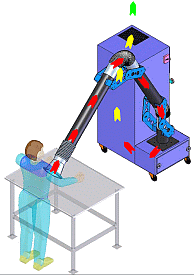
Machine Shop - Surface Grinders
Surface grinding is used to produce a smooth finish on flat surfaces. It is a widely used abrasive machining process in which a spinning wheel covered in rough particles (grinding wheel) cuts chips of metallic or nonmetallic substance from a work-piece, making a face of it flat or smooth. Some of the keys to designing successful dust and mist collection system for surface grinding are as follows:
For a full list of engineering control methods, see below
- Determine the toxicity of the metals. for example, some metals contain Hexavalent chrome which is a carcinogen and must have HEPA filtration as per OSHA. More info on the hazards of Hexavalent chrome can be found here
- DRY or WET grinding. Dry grinding needs to have its explosivity analyzed (KST) value. If the dust is explosive, you will want to select the appropriate dust collector for explosive applications. More info can be found here: https://www.osha.gov/OshDoc/data_General_Facts/OSHAcombustibledust.pdf If the application is WET and is not dust that releases hydrogen, EG: aluminum, you can select a filter that handles both Wet and Dry dust, always paying attention to the explosion, Fire and inhalation hazards.
- Duct Velocity (AKA: Transport velocity) is best above 3500 FPM for non-explosive applications and 4500 FPM for explosive applications.
- Capture of the dust is commonly done in 2 ways. 1- "on-tool" spot extraction where you capture the dust right at the source. 2 - LEV where the dust is captured at the end of the grinding bed. LEV captures just the fine respirable dust, where "on-tool captures larger non-respirable particles. For a detailed evaluation of your process, click here: https://lev-co.com/contact/
For a full list of engineering control methods, see below
For further support, please contact us directly at 1-888-862-5356.
At-Source Capture Systems
Ducted Air Cleaners
Mist Collectors
Portable Filter Units



